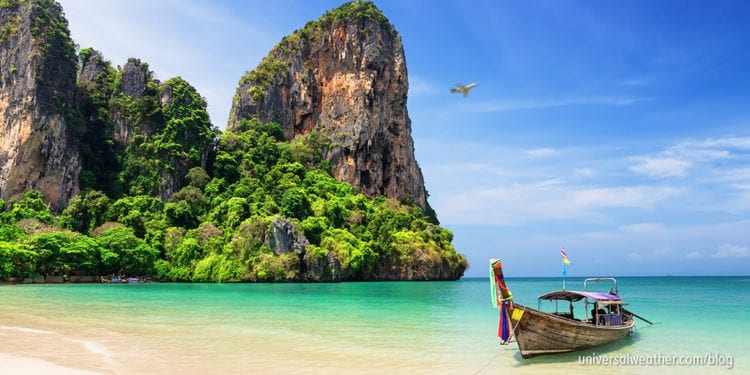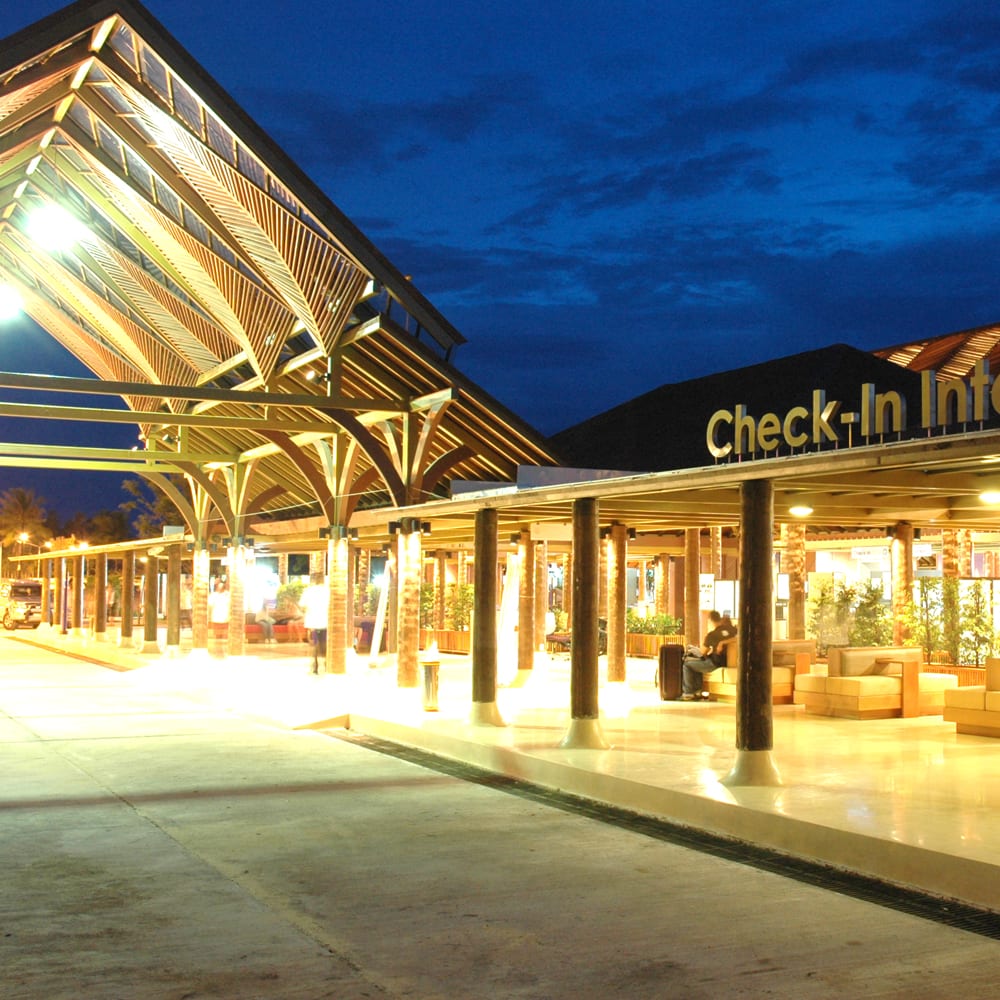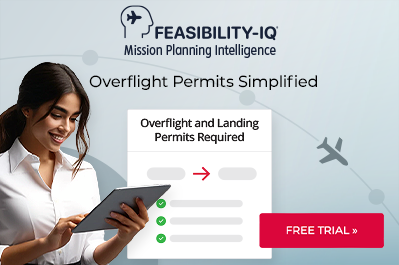Business Aviation Destination Guide: Koh Samui, Thailand

Koh Samui, Thailand is world-renowned for its beautiful, white sand, palm-lined beaches and luxurious resorts. It is Thailand’s second largest island, after Phuket, and is located in the Gulf of Thailand. It’s a popular tourist destination, receiving more than two million foreign visitors annually, with that number expected to grow as the island continues to make airport and infrastructure enhancements.
Despite the island’s popularity, operating there on a business aircraft was historically challenging due to a four-night max parking limitation at Koh Samui Airport (VTSM). In recent years, however, a partnership between Bangkok Airways and Universal Aviation Thailand has eliminated this restriction and increased ground handling service levels, making the island a more desirable leisure destination for business aviation leisure trips.
If you’re considering traveling to Koh Samui on a business aircraft, here’s what you need to know:
1. Koh Samui Airport
Koh Samui Airport (VTSM) is Thailand’s only private airport – built and owned by Bangkok Airways. It is located approximately 3.5 kilometers and 30 minutes from the city center.

Note: Aircraft with MTOW over 70 tons are not permitted at VTSM.
- Hours: VTSM is open from 06:00-22:00 local, but private and general aviation are limited to operating hours of 07:00 – 21:00 local. Overtime and after-hours operations are restricted to local ambulance flights only.
- Slots: Slot requests take five working days to be approved and must be submitted to Civil Aviation Authority of Thailand (CAAT). Upon approval, the slot window is open for +24 hours and -24 hours.
- PPRs: Slot must be approved in order to apply for a Thailand Landing Permit. Submissions should be at least 3-5 working days prior to arrival schedule.
- Parking: In 2017, Universal Aviation Thailand and Bangkok Airways entered into an agreement to work together to improve the experience for business aviation operators at VTSM and improve and maximize the airport’s parking capacity.
Prior to the agreement, there was a four-night max parking restriction at the airport. Operators staying longer were required to reposition their aircraft. This restriction has been eliminated, and long-term parking is now available at VTSM. Parking is approved upon availability and is generally available April through September. During peak season (October through March), it’s best to request spots well in advance.
2. Handling
Ground handling and third-party services are arranged by PGGS (Bangkok Airways Ground Services), including ramp and passenger services, catering, ground transportation, security, ground support equipment, flight procedure and dispatch.
To ensure the experience on the ground matches the level of service business aviation operators expect, Universal Aviation Thailand provides ongoing customer service training and ramp safety training to
- FBOs: VTSM does not have an FBO or dedicated general aviation facility. All facilities are shared between private and commercial passengers. Universal Aviation Thailand and Bangkok Airways are working together on plans to add a small dedicated business aviation terminal facility adjacent to the ramp in the future.
- Equipment: Aircraft must carry their own tow bar when operating to VTSM.
3. Accommodations
Koh Samui is serviced by more 5-star hotels and resorts than Phuket, in addition to many private luxury villas.
4. Ground transport
Ground handling and third-party services are arranged by PGGS (Bangkok Airways Ground Services) including ramp and passenger services, catering, ground transportation, security, ground support equipment, flight procedure and dispatch.
- Helicopter transfers: Helicopter transfers are available to VTSM. They must follow the same slot and parking procedures as business and private aviation.
5. Fuel
Fuel services are coordinated by BAFS (Bangkok Aviation Fuel Services PCL) providing JET A1. Payment is by credit only. Credit card and cash are unavailable.
There are no issues refueling on arrival. However, when refueling it is recommended not to fill up an aircraft with full tank, as it may have a higher risk of fuel leak to the ramp with the high ramp temperature. It is recommended to upload a significant amount of fuel and possibly top it off on departure operation/leg.
Note: There is no dedicated fuel truck for general aviation at VTSM.
6. Catering
Bangkok Air Catering (BAC) is the only provider at VTSM.
7. Security
Security at VTSM is provided by the airport and is considered strong.
8. Permits (Landing)
PGGS (Bangkok Airways Ground Services) coordinates with VTSM airport for slot and landing permits.
9. Cabotage
Private flights with the exact same group of passengers on arrival and/or departure into/out of Thailand can fly domestic legs.
No charter flights are allowed to fly domestic legs in Thailand.
Additional passengers boarding on domestic legs, must declare to CAAT their relationship with the aircraft owner and that the flight is private. If it’s charter, it is not permitted.
The operator must present a letter of declaration to CAAT when submitting a landing permit for a flight that might operating under cabotage conditions.
10. Customs
CIQ is available at VTSM. CIQ must be cleared upon landing at Arrival Gate 5 in the airport’s main terminal. Documentation pre-arrangement is available.
- Visas: Visa requirements can change with little or no notice. Please double-check foreign entry requirements for travelers from your country/territory of nationality by contacting the local embassy or consulate of your destination country/territory.
- APIS: Not applicable.
11. Flight planning
Flight plans must be submitted by operators six hours prior to departure.
12. Weather considerations
The dry season in Koh Samui runs roughly from December to February. It offers warm yet bearable temperatures, little rain, calm seas, and light winds.
September through November is the peak of the monsoon and, therefore, sees the heaviest rainfall. Even at this time, it doesn’t rain daily and when it does, it’s usually only in short bursts.
13. Tech stops
Not applicable.
14. Peak season
Peak season for the island is from October to March. The hottest time of year is between March and May. This period marks the beginning of the monsoon and an increase in rainfall.
15. Regulatory considerations
Not applicable.
16. Other considerations
- Vaccinations: There is no risk of yellow fever in Thailand. The government of Thailand requires proof of yellow fever vaccination only if travelers are arriving from a country with risk of yellow fever. Click here for more information.
- Language issues: Not applicable.
- Special documentation: Don’t forget that consular officers reserve the rights to request for additional documents when they deemed it necessary, so it is advisable that passengers present themselves in a good shape and state, together with papers and documents. Required docs include:
- Passport or travel document with a validity not less than six months
- Visa application form (filled out)
- One (1) recent 4x6cm. Photograph of the applicant (color)
- Round-trip air ticket or e-ticket (paid in full)
- Proof of financial means (20,000 baht per person/40,000 baht per family)
- Pets: For those who travel with pets and seek to pass them through Thailand, everything can be done at the port of entry by having the following required documents ready before arrival:
1) Form Ror. 1/1 (ร. 1/1) from Thai Department of Livestock Development
2) Health Certificate:- A health certificate must be endorsed by USDA/APHIS Veterinary Services office prior to the pet’s departure.
- To locate a USDA/APHIS Veterinary Services office in your area, please visit: www.aphis.usda.gov/aphis/pet-travel/service-centers-endorsement-offices
- Since an endorsed health certificate will be valid for 10 days from the date signed/issued by the USDA/APHIS Veterinary Services office, the pet’s owner shall travel with pets and arrive at the Suvarnnabhumi International Airport within 10 days after endorsement.
- Weapons: The following are the procedures to bring firearms into Thailand:
- Traveler will have to fill the information on the Application for Firearm and Ammunition import permit form. (The serial number on the actual firearm must exactly match the serial number on the permit application.)
- Prepare a photocopy of passport, sign the photocopy and send by mail or scan and e-mail with the firearm import form to organizer/agent.
- Organizer/Agent will apply for the temporary import permit, and send to traveler before arrival.
- Traveler will need to bring the print out documents and declare to customs office. Ammunition imported to Thailand might subject to pay import tax (30 percent of purchase price). The officer will check firearms against the permit (serial number, caliber) Note: Firearms or realistic replicas of firearms must be presented unloaded and locked in a hard-sided container.
Conclusion
Koh Samui is an idyllic island paradise, but historically limited parking and a lack of airport services up to the standards of business aviation operators has limited its appeal to private jet operators. Recent changes in service levels and the elimination of the parking restriction have raised the island’s profile, and it is seeing a resulting surge in popularity among business aviation operators.




